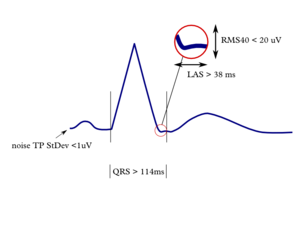Late potentials: Difference between revisions
Jump to navigation
Jump to search
mNo edit summary |
mNo edit summary |
||
| Line 1: | Line 1: | ||
Late potentials are thought to be caused by early afterdepolarizations of cells in the right ventricle (in [[ARVD]]). Their amplitude is often too small to show up on a normal ECG. However, when multiple QRS recordings (typically 250 consecutive QRS complexes) are averaged, random noise is filtered out and late potentials can show up. Such a recording is called a Signal Averaged ECG (SAECG). | Late potentials are thought to be caused by early afterdepolarizations of cells in the right ventricle (in [[ARVD]]). Their amplitude is often too small to show up on a normal ECG. However, when multiple QRS recordings (typically 250 consecutive QRS complexes) are averaged, random noise is filtered out and late potentials can show up. Such a recording is called a Signal Averaged ECG (SAECG). | ||
The ARVD taskforce has published a document with [http://arvd.org/SAECG%20protocol.pdf recommended settings] to record an SAECG in ARVD. | |||
[[Image:late_potentials.png|thumb]] | [[Image:late_potentials.png|thumb]] | ||
{| class="wikitable" | {| class="wikitable" | ||
Latest revision as of 11:27, 23 March 2011
Late potentials are thought to be caused by early afterdepolarizations of cells in the right ventricle (in ARVD). Their amplitude is often too small to show up on a normal ECG. However, when multiple QRS recordings (typically 250 consecutive QRS complexes) are averaged, random noise is filtered out and late potentials can show up. Such a recording is called a Signal Averaged ECG (SAECG). The ARVD taskforce has published a document with recommended settings to record an SAECG in ARVD.
| Criteria for late potentials on a signal averaged ECG [1][2] |
|---|
|
References
- Simson MB. Use of signals in the terminal QRS complex to identify patients with ventricular tachycardia after myocardial infarction. Circulation. 1981 Aug;64(2):235-42. DOI:10.1161/01.cir.64.2.235 |
- Breithardt G, Cain ME, el-Sherif N, Flowers NC, Hombach V, Janse M, Simson MB, and Steinbeck G. Standards for analysis of ventricular late potentials using high-resolution or signal-averaged electrocardiography: a statement by a task force committee of the European Society of Cardiology, the American Heart Association, and the American College of Cardiology. J Am Coll Cardiol. 1991 Apr;17(5):999-1006. DOI:10.1016/0735-1097(91)90822-q |
